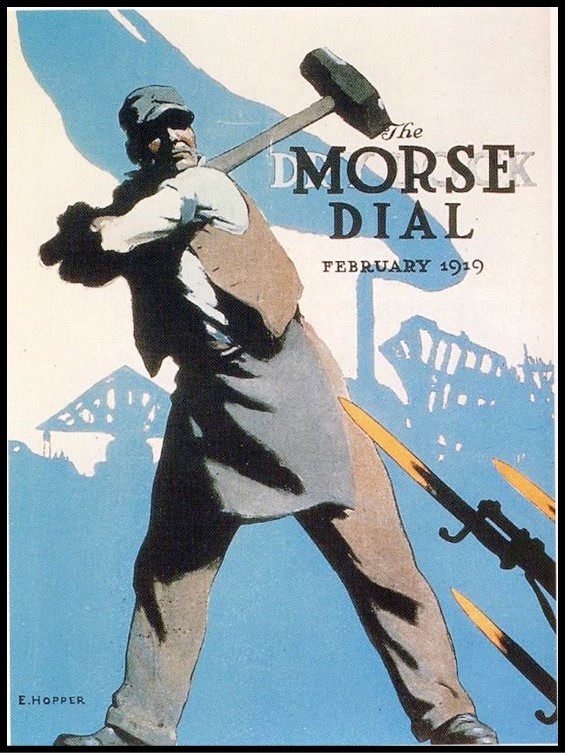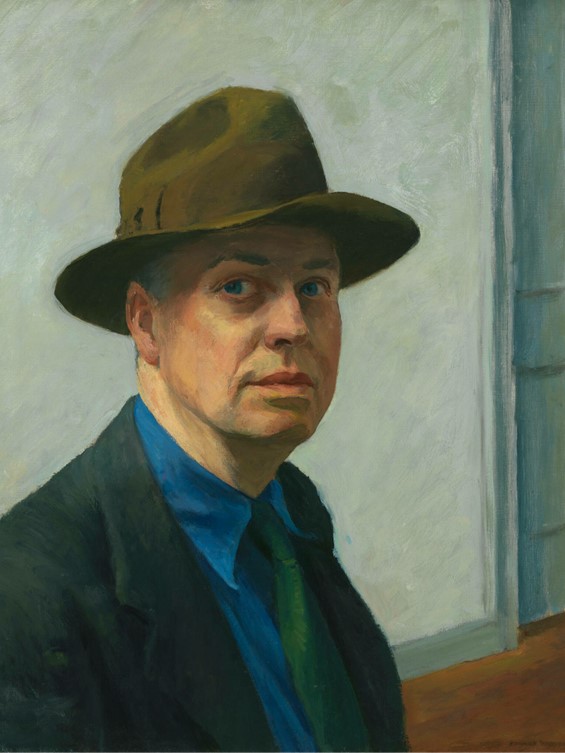
Smash the Hun, 1918, WWI poster by Edward Hopper for the in-house magazine of the Morse Dry Dock and Repair Company in Brooklyn, where Hopper worked as an illustrator (issue of Feb 1919)
https://rockwellcenter.org/wp-content/uploads/2011/06/Hopper-Smash-the-Hun1.jpg
The American artist Edward Hopper is acknowledged as one of the most significant artists of the 20th century. He is known for his oil paintings of urban life scenes, behind windows and across streets, dating from the 1920s to the 1960s, some of which have become highly popular images, like the Nighthawks (1942, Oil on canvas, 84.1 x 152.4 cm, Art Institute of Chicago). He is less known for the attention he has paid to landscapes, particularly landscapes of New England, like Cape Ann Granite (1928. Oil on canvas, 73.5 x 102.3 cm. Private Collection). He is even less known for his early illustrations… like Smash the Hun…his ticket to success.

Self-Portrait, 1925–1930, Oil on Canvas, 64.5 × 51.8 cm, Whitney Museum of American Art, NY, USA https://whitney.org/collection/works/6068
In 1918 Edward Hopper was thirty-six years old and still struggling for artistic recognition. He was born on July 22, 1882, in the charming riverfront village of Upper Nyack, New York, where he spent his formative years. He grew up, comfortably, embraced by an educated family that was involved in the arts, and went to museums, concerts, and other cultural events. Inclined to draw as a child, Hopper was supported by his family to pursue the arts, but being of practical mind, his parents suggested he chose to study Illustration for a career that would provide him a steady income. Hopper took courses at the Correspondence School of Illustrating and at the New York School of Art. Noted illustrator/painters Arthur Keller, Frank Vincent Du Mond, Kenneth Hayes Miller, and Robert Henri were among his teachers, and John Sloan, who worked regularly as a commercial illustrator prior to 1916, was an early influence. His strong, and dynamic illustrations for trade publications are memorable… but this is not what he really wanted, and by 1918 he was getting restless… https://www.thoughtco.com/edward-hopper-biography-4165484 and https://www.mutualart.com/Exhibition/Unknown-Hopper–Edward-Hopper-as-Illustr/3CFFF3BDEE4BBFF2
Unduly… it was the art of illustration that won Hopper his first kind of fame. According to Gail Levin, who wrote Edward Hopper: An Intimate Biography, Bert Edward Barnes, editor of the Morse Dry Dock Dial, liked his work and probably persuaded him to enter the contest for a propaganda poster sponsored by the United States Shipping Board Emergency Fleet Corporation in 1918. The agency had been created in September 1916 with the authority to build, purchase, lease, or requisition vessels needed for the war effort.
Barnes encouraged Hopper to visit the shipyard to get the right feel, and volunteered one of his employees, Pete Shea, to model for the poster. He also had Shea photographed in the pose and gave a print to Hopper, who recalled in an ironical sketch: “I got this big Irishman to pose for me in the shipyards, with the background of ship’s ribs, that sort of things. I had his swigging a maul, and the maul was aimed at a bloody bayonet sticking unpin one corner. I titled it ‘Smash the Hun’; it was pretty awful and I don’t think it was ever published.” In fact, Hopper’s design appeared on the cover of the Morse Dry Dock Dial for February 1919.
The four-colour poster won Hopper the three-hundred-dollar first prize among fourteen hundred contestants. Since the armistice was declared before the poster could be reproduced for mass distribution, Hopper’s fame came from the exhibition of Smash the Hun along with nineteen other finalists in August 1918, in the window of Gimbel’s department store on Broadway, where, according to the press, ‘thousands’ saw the ‘stirring pictures placed on vie.’ The papers reported that the wave of popular excitement swept up Hopper’s model, Shea: he enlisted in the Navy.
Interesting to read… Edward Hopper: An Intimate Biography by Gail Levin https://books.google.gr/books?id=6Dh2gFK-lecC&pg=PA117&lpg=PA117&dq=Hopper+Smash+the+Hun&source=bl&ots=qjJ-w8SQPt&sig=ACfU3U2U_AkbuBJuhjWMNGjQXS_edv90bw&hl=el&sa=X&ved=2ahUKEwif6dug0Yf6AhXGSPEDHWFXCpw4ChDoAXoECBQQAw#v=onepage&q=Hopper%20Smash%20the%20Hun&f=false pp. 108, 116-117
For a PowerPoint, titled Edward Hopper: The Early Years, please… Check HERE!
An interesting Video Presentation of The Unknown Hopper: Edward Hopper as Illustrator. The Video was created for the Exhibition that was on view at Norman Rockwell Museum between June 7, 2014 to October 26, 2014… https://www.facebook.com/historyofart2016/videos/200213034763003
The origins of Edward Hopper’s earliest oil paintings by Louis Shadwick “cuts straight through the widely held perception of Hopper as an American original,” and helps the reader understand Hopper’s artistic journey. https://burlington.org.uk/media/_file/generic/202010-42790.pdf and https://www.smithsonianmag.com/smart-news/some-edward-hoppers-earliest-works-were-copies-180975958/